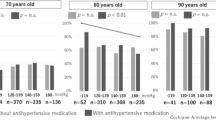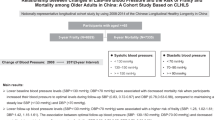Abstract
Objectives
Variation in repeated blood pressure measurements may represent a decline in homeostatic mechanisms in blood pressure regulation in response to various internal or external stressors, indicating a frail state. We tested this hypothesis by examining the association between variability in repeated blood pressure measurements (BPV) and frailty status, adjusting for other confounding factors.
Design
A longitudinal cohort study.
Setting
Community centres in all three regions of Hong Kong.
Participants
1156 community-living older adults aged 60 years and over participated in a community geriatric screening program with blood pressure measurements three times a week over one year. Participants were divided into three groups based on variability of repeated blood pressure measurements (low, medium, high) using machine learning methods.
Measurements
Frailty status was assessed using the FRAIL scale. Logistic regression was used to examine cross sectional association between frailty status and BPV adjusting for confounding factors, and also frailty transition with BPV.
Results
In multi-variate models adjusting for co-variates, high BPV was associated with frailty (OR 1.57; 95% CI 1.05-2.37) among all participants; however, this was only significant in women in subgroup analysis. Similar findings were observed when transition to a more frail state was examined over a twelve month period.
Conclusions
The findings of this study support the concept of physiological dysregulation underlying the frail state, and that BPV calculated using machine learning methods may be used as a biomarker of such dysregulation.





Similar content being viewed by others
References
Clegg A, Young J. The frailty syndrome. Clin Med (Lond) 2011;11(1):72–5.
Varadhan R, Seplaki CL, Xue QL, Bandeen-Roche K, Fried LP. Stimulus-response paradigm for characterizing the loss of resilience in homeostatic regulation associated with frailty. Mech Ageing Dev 2008;129(11):666–70.
Miller BF, Seals DR, Hamilton KL. A viewpoint on considering physiological principles to study stress resistance and resilience with aging. Ageing Res Rev 2017;38:1–5.
Walston JD. Conceptualizing frailty and resiliency and their physiological basis. Innovation in Aging 2017;1(S1):664.
Fried LP. Interventions for Human Frailty: Physical Activity as a Model. Cold Spring Harbor Perspectives in Medicine 2016;6(6):a025916.
Fried LP, Xue QL, Cappola AR, Ferrucci L, Chaves P, Varadhan R, et al. Nonlinear Multisystem Physiological Dysregulation Associated With Frailty in Older Women: Implications for Etiology and Treatment. Journals of Gerontology Series a-Biological Sciences and Medical Sciences 2009;64(10):1049–1057.
Li Q, Wang SR, Milot E, Bergeron P, Ferrucci L, Fried LP, et al. Homeostatic dysregulation proceeds in parallel in multiple physiological systems. Aging Cell 2015;14(6):1103–1112.
Mitnitski A, Collerton J, Martin-Ruiz C, Jagger C, von Zglinicki T, Rockwood K, et al. Age-related frailty and its association with biological markers of ageing. Bmc Medicine 2015;13.
Rodriguez-Manas L. Contribution of the frailomic initiative to the biological understanding of frailty and resiliency. Innovation in Aging 2017;1(S1):665.
Calvani R, Marini F, Cesari M, Tosato M, Picca A, Anker SD, et al. Biomarkers for physical frailty and sarcopenia. Aging Clinical and Experimental Research 2017;29(1):29–34.
Giannattasio C, Ferrari AU, Mancia G. Alterations in Neural Cardiovascular Control Mechanisms with Aging. Journal of Hypertension 1994;12:S13–S17.
Sabayan B, Wijsman LW, Foster-Dingley JC, Stott DJ, Ford I, Buckley BM, et al. Association of visit-to-visit variability in blood pressure with cognitive function in old age: prospective cohort study. Bmj-British Medical Journal 2013;347.
McAdams M, Ying H, Olorundare I, Gross A, Xue Q, Walston JD, et al. Frailty and the blood pressure response to the stressor of hemodialysis among older patients. Innovation in Aging 2017;1(S1):23.
Goh CH, Ng SC, Kamaruzzaman SB, Chin AV, Tan MP. Standing beat-to-beat blood pressure variability is reduced among fallers in the Malaysian Elders Longitudinal Study. Medicine 2017;96(42).
Cohen AA, Milot E, Li Q, Legault V, Fried LP, Ferrucci L. Cross-population validation of statistical distance as a measure of physiological dysregulation during aging. Experimental Gerontology 2014;57:203–210.
Bangalore S, Fayyad R, Messerli FH, Laskey R, DeMicco DA, Kastelein JJP, et al. Relation of Variability of Low-Density Lipoprotein Cholesterol and Blood Pressure to Events in Patients With Previous Myocardial Infarction from the IDEAL Trial. American Journal of Cardiology 2017;119(3):379–387.
Rothwell PM, Howard SC, Dolan E, O’Brien E, Dobson JE, Dahlof B, et al. Prognostic significance of visit-to-visit variability, maximum systolic blood pressure, and episodic hypertension. Lancet 2010;375(9718):895–905.
Woo J, Leung J. Multi-morbidity, dependency, and frailty singly or in combination have different impact on health outcomes. Age 2014;36(2):923–931.
Woo J, Yu R, Wong M, Yeung FN, Wong M, Lum C. Frailty Screening in the Community Using the FRAIL Scale. Journal of the American Medical Directors Association 2015;16(5):412–419.
Buta BJ, Walston JD, Godino JG, Park M, Kalyani RR, Xue QL, et al. Frailty assessment instruments: Systematic characterization of the uses and contexts of highly-cited instruments. Ageing Research Reviews 2016;26:53–61.
Woo J, Goggins W, Sham A, Ho SC. Public health significance of the frailty index. Disability and Rehabilitation 2006;28(8):515–521.
Dent E, Lien C, Lim WS, Wong WC, Wong CH, Ng TP, et al. The Asia-Pacific Clinical Practice Guidelines for the Management of Frailty. Journal of the American Medical Directors Association 2017;18(7):564–575.
Sinclair AJ, Abdelhafiz A, Dunning T, Izquierdo M, Rodriguez Manas L, Bourdel-Marchasson I, et al. An International Position Statement on the Management of Frailty in Diabetes Mellitus: Summary of Recommendations 2017. J Frailty Aging 2018;7(1):10–20.
Afilalo J, Alexander KP, Mack MJ, Maurer MS, Green P, Allen LA, et al. Frailty assessment in the cardiovascular care of older adults. J Am Coll Cardiol 2014;63(8):747–62.
Tse G, Gong M, Nunez J, Sanchis J, Li G, Ali-Hasan-Al-Saegh S, et al. Frailty and Mortality Outcomes After Percutaneous Coronary Intervention: A Systematic Review and Meta-Analysis. J Am Med Dir Assoc 2017;18(12):1097 e1–1097 e10.
Woo J, Leung J, Morley JE. Comparison of frailty indicators based on clinical phenotype and the multiple deficit approach in predicting mortality and physical limitation. J Am Geriatr Soc 2012;60(8):1478–86.
Author information
Authors and Affiliations
Corresponding author
Rights and permissions
About this article
Cite this article
Woo, J., Yu, R., Tsoi, K. et al. Variability in Repeated Blood Pressure Measurements as a Marker of Frailty. J Nutr Health Aging 22, 1122–1127 (2018). https://doi.org/10.1007/s12603-018-1082-9
Received:
Accepted:
Published:
Issue Date:
DOI: https://doi.org/10.1007/s12603-018-1082-9




